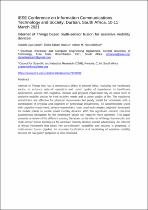JavaScript is disabled for your browser. Some features of this site may not work without it.
- ResearchSpace
- →
- Research Publications/Outputs
- →
- Journal Articles
- →
- View Item
| dc.contributor.author |
Daniel, OA

|
|
| dc.contributor.author |
Markus, ED

|
|
| dc.contributor.author |
Abu-Mahfouz, Adnan MI

|
|
| dc.date.accessioned | 2021-07-13T17:55:46Z | |
| dc.date.available | 2021-07-13T17:55:46Z | |
| dc.date.issued | 2021-03 | |
| dc.identifier.citation | Daniel, O., Markus, E. & Abu-Mahfouz, A.M. 2021. Internet of things based multi-sensor fusion for assistive mobility devices. http://hdl.handle.net/10204/12054 . | en_ZA |
| dc.identifier.isbn | 978-1-7281-8081-6 | |
| dc.identifier.isbn | 978-1-7281-8082-3 | |
| dc.identifier.uri | DOI: 10.1109/ICTAS50802.2021.9395010 | |
| dc.identifier.uri | http://hdl.handle.net/10204/12054 | |
| dc.description.abstract | Internet of Things has had a tremendous effect in several fields, including the healthcare sector, to enhance network operation and users' quality of experience. In healthcare applications, people with cognitive, mental, and physical impairment rely on some form of assistive mobility device for their mobility needs and a better quality of life. The traditional wheelchairs are effective for physical impairments but poorly suited for individuals with a combination of physical and cognitive or perceptual impairments. To accommodate users with cognitive impairment, several researchers have used technologies originally developed for mobile robots to create smart mobility devices. With this significant interest, real-time autonomous navigation for the healthcare sector still requires more attention. This paper presents a review of the different existing literature on the internet of things frameworks and multi-sensor fusion techniques for assistive mobility devices (smart wheelchair). An Internet of things framework that takes into consideration scalability and security is proposed. A multi-sensor fusion pipeline for accurate localization and monitoring of assistive mobility devices for navigation purposes is also proposed. | en_US |
| dc.format | Abstract | en_US |
| dc.language.iso | en | en_US |
| dc.relation.uri | https://ieeexplore.ieee.org/abstract/document/9395010 | en_US |
| dc.source | IEEE Conference on Information Communications Technology and Society, Durban, South Africa, 10-11 March 2021 | en_US |
| dc.subject | Assistive mobility devices | en_US |
| dc.subject | Internet of Things | en_US |
| dc.subject | IoT | en_US |
| dc.subject | Mobility devices | en_US |
| dc.title | Internet of things based multi-sensor fusion for assistive mobility devices | en_US |
| dc.type | Conference Presentation | en_US |
| dc.description.pages | 6pp | en_US |
| dc.description.note | ©2021 IEEE. Due to copyright restrictions, the attached PDF file only contains the abstract version of the full text item. For access to the full text item, please consult the publisher's website: https://ieeexplore.ieee.org/abstract/document/9395010 | en_US |
| dc.description.cluster | Next Generation Enterprises & Institutions | |
| dc.description.impactarea | EDTRC Management | |
| dc.identifier.apacitation | Daniel, O., Markus, E., & Abu-Mahfouz, A. M. (2021). Internet of things based multi-sensor fusion for assistive mobility devices. http://hdl.handle.net/10204/12054 | en_ZA |
| dc.identifier.chicagocitation | Daniel, OA, ED Markus, and Adnan MI Abu-Mahfouz. "Internet of things based multi-sensor fusion for assistive mobility devices." <i>IEEE Conference on Information Communications Technology and Society, Durban, South Africa, 10-11 March 2021</i> (2021): http://hdl.handle.net/10204/12054 | en_ZA |
| dc.identifier.vancouvercitation | Daniel O, Markus E, Abu-Mahfouz AM, Internet of things based multi-sensor fusion for assistive mobility devices; 2021. http://hdl.handle.net/10204/12054 . | en_ZA |
| dc.identifier.ris | TY - Conference Presentation AU - Daniel, OA AU - Markus, ED AU - Abu-Mahfouz, Adnan MI AB - Internet of Things has had a tremendous effect in several fields, including the healthcare sector, to enhance network operation and users' quality of experience. In healthcare applications, people with cognitive, mental, and physical impairment rely on some form of assistive mobility device for their mobility needs and a better quality of life. The traditional wheelchairs are effective for physical impairments but poorly suited for individuals with a combination of physical and cognitive or perceptual impairments. To accommodate users with cognitive impairment, several researchers have used technologies originally developed for mobile robots to create smart mobility devices. With this significant interest, real-time autonomous navigation for the healthcare sector still requires more attention. This paper presents a review of the different existing literature on the internet of things frameworks and multi-sensor fusion techniques for assistive mobility devices (smart wheelchair). An Internet of things framework that takes into consideration scalability and security is proposed. A multi-sensor fusion pipeline for accurate localization and monitoring of assistive mobility devices for navigation purposes is also proposed. DA - 2021-03 DB - ResearchSpace DP - CSIR J1 - IEEE Conference on Information Communications Technology and Society, Durban, South Africa, 10-11 March 2021 KW - Assistive mobility devices KW - Internet of Things KW - IoT KW - Mobility devices LK - https://researchspace.csir.co.za PY - 2021 SM - 978-1-7281-8081-6 SM - 978-1-7281-8082-3 T1 - Internet of things based multi-sensor fusion for assistive mobility devices TI - Internet of things based multi-sensor fusion for assistive mobility devices UR - http://hdl.handle.net/10204/12054 ER - | en_ZA |
| dc.identifier.worklist | 24633 | en_US |






